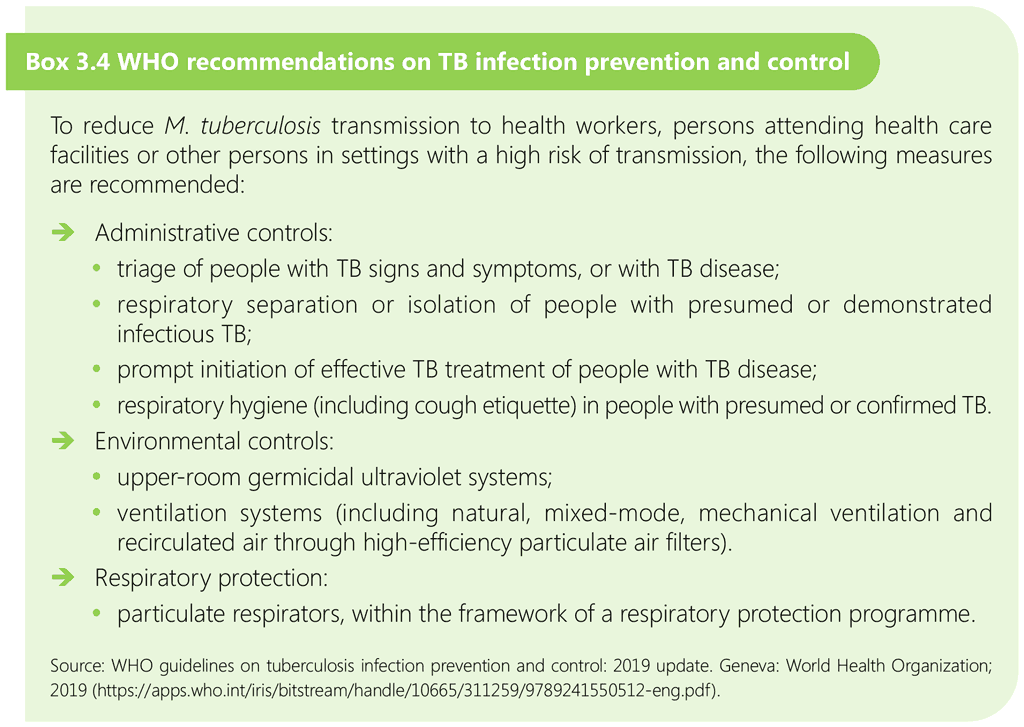Links de passagem do livro para 3.4 TB infection prevention and control
The End TB Strategy emphasizes the need for prevention across all efforts to end the TB epidemic, including infection prevention and control in health care services and other high-transmission settings (7). Infection prevention and control practices are critical to reduce the risk of M. tuberculosis transmission, by reducing the concentration of infectious droplet nuclei in the air and the exposure of susceptible people to such aerosols. Although the recommendations in the WHO guidelines on tuberculosis infection prevention and control: 2019 update do not specifically mention children or adolescents, the principles of infection control outlined remain relevant (70). Specifically, adolescents aged 10–19 years pose the same transmission risk as adults with TB, given similar disease profiles. Children aged under 10 years are unlikely to transmit disease, but the same principles apply to health care facilities where children and their families seek care. In addition, poor infection prevention and control practices that facilitate transmission invariably affect children when an adult or adolescent transmits TB to a child.
The COVID-19 pandemic has resulted in routine mask-wearing in many settings, which may have reduced the stigma related to the use of masks by people with TB. This may facilitate implementation of cough etiquette by people attending health care facilities and respiratory protection by HCWs.

In high TB prevalence settings, children and adolescents who attend health facilities are at risk of TB transmission, and adolescents are likely to pose a transmission risk themselves. The risk of developing TB after infection is especially high for infants and young children, and for all children and adolescents living with HIV who visit health facilities. People with (presumptive) TB should not share a waiting area with infants attending for immunizations or well-baby checks, or children and adolescents at HIV clinics. All children (rare) and adolescents (common) with cavitary or sputum smear-positive TB disease should be isolated. The risk of exposure is particularly high in facilities caring for adults with TB and/or HIV. TB is the most common opportunistic infection in adults living with HIV and of childbearing or parenting age.
Children with TB are often considered not to be infectious and therefore not likely to transmit TB, but adolescents and sometimes younger children do transmit TB. Infection control is therefore important in health facilities and areas dedicated solely to the management of children. The greatest risk occurs in areas where young and vulnerable children mix with adults and adolescents with presumptive TB who are not on treatment. In addition, there is a high risk of unsuspected and untreated TB disease among adults accompanying or visiting such children. The clinical presentation of TB in children is variable and often overlaps with that of pneumonia, HIV and malnutrition, and therefore infection control measures are relevant to all outpatient and inpatient areas where children attend (6).
Specific high-risk areas include:
- newborn care settings – neonates are highly vulnerable for acute onset or development of disseminated severe disease, and adults with cough should not be allowed to visit;
- health facilities that care for adults and adolescents with presumptive TB, who are often infectious (especially before being diagnosed and started on treatment);
- antenatal care settings and prevention of mother-to-child transmission sites;
- HIV clinics;
- facilities that care for children with severe malnutrition;
- other congregate settings, including childcare facilities, orphanages, prisons and schools – school-aged children with bacteriologically confirmed TB should not attend school until they are no longer infectious (usually 2 weeks after starting effective TB treatment for drug-susceptible TB); it is important, however, that children and adolescents with TB return to school as soon as possible, if they are well enough to do so after at least 2 weeks of treatment, to minimize disruption of education; school management must be informed accordingly, including that mask-wearing is not needed for children and adolescents who are not infectious (both for the child with TB and for other children in the class);
- children in displaced and mobile populations, including migrant labour camps, informal and crowded refugee camps, and temporary shelters.
 Opinião
Opinião